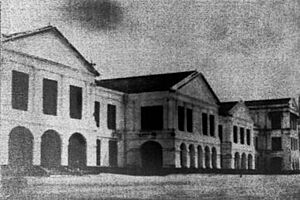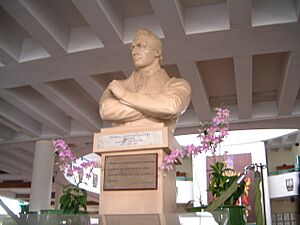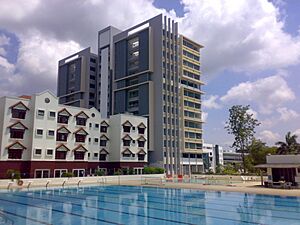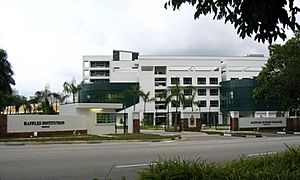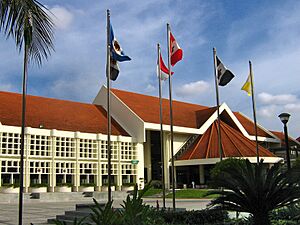Raffles Institution facts for kids
Quick facts for kids Raffles Institution |
|
|---|---|
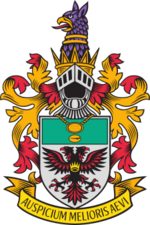 |
|
| Address | |
|
1 Raffles Institution Lane
Singapore 575954 |
|
| Information | |
| Type | Independent |
| Motto | Auspicium Melioris Aevi (Latin) (Hope of a Better Age) |
| Founded | 5 June 1823 |
| Founder | Stamford Raffles |
| Sister school | Raffles Girls' School |
| Chairman | Bey So Khiam |
| Principal | Aaron Loh |
| Gender | Boys (Year 1-4) Mixed (Year 5-6) |
| Enrolment | 4,000 |
| Colour(s) | Green Black White |
| Mascot | Gryphon and eagle |
| Team name | Team Raffles |
| Publication | The Rafflesian Times |
| Yearbook | The Rafflesian |
Raffles Institution (RI) is a famous school in Singapore. It was started in 1823, making it the oldest school in the country. RI offers education for boys from Year 1 to Year 4 (secondary school). For Years 5 and 6 (pre-university), it welcomes both boys and girls.
Since 2007, RI and its partner school, Raffles Girls' School, have a special program called the Raffles Programme. This program lets students skip the O-Level exams. Instead, they go straight to take the A-Level exams at the end of Year 6. This gives students more time for other activities and learning.
RI is known for producing many successful people. These include 96 President's Scholars, three presidents, and five prime ministers of Singapore. Many other important leaders and business people also studied at RI. For example, former Prime Ministers Lee Kuan Yew and Goh Chok Tong are alumni. The school also has a high number of students accepted into top universities worldwide.
Contents
School History
How Raffles Institution Started
Raffles Institution was founded by Stamford Raffles. He suggested starting "the Institution" on April 1, 1823. Raffles wanted to create a college for the people of Singapore. He hoped it would help educate children of Malay rulers and leaders. It was also meant for company employees and anyone wanting to learn local languages.
Raffles believed this school would help "civilise and better the conditions of millions" beyond Singapore. Many people helped with the plan, including Reverend Robert Morrison. Raffles gave money and got a grant from the British East India Company. He also designed the school's curriculum.
The first building for RI was on Bras Basah Road. Raffles laid the first stone on June 5, 1823. This was just before he left Singapore for the last time. The building took a long time to finish. In 1835, people raised money to complete it. George Drumgoole Coleman was hired to finish the building.
Early School Days
On August 1, 1834, the Singapore Free School opened with 46 boys. When the Institution's building was ready in 1837, the Free School moved in. It became the Institution Free School. At first, it taught Malay, Chinese, and English. But soon, it became an English-only school. In 1856, it was renamed Singapore Institution.
In the 1860s, the school grew into a high school. In 1868, it was officially named Raffles Institution. This was to honor its founder, Stamford Raffles. Two important headmasters, J. B. Bayley and R. W. Hullett, led the school for many years.
RI was the first school in Singapore to accept girls. Eleven girls joined in 1844. In 1879, the girls' section became a separate school, Raffles Girls' School.
Moving to New Locations
In March 1972, the school moved to Grange Road. The old building was taken down. Today, Raffles City Shopping Centre stands in its place. The library building from the old campus is even shown on Singapore's S$2 note.
In 1984, RI was chosen to start a special program. This program, called the Gifted Education Programme, helps very smart students. In 1990, the school moved again to a new campus in Bishan.
Raffles Junior College
In 1982, Raffles Junior College (RJC) was created. It took over the pre-university education from RI. RJC moved to its own campus in 1984.
In 2004, the six-year Raffles Programme began. This program lets students skip the O-Level exams. They go straight to RJC for Years 5 and 6. Then they take the A-Level exams. This gives students more time for other activities. The goal is to help students become leaders.
In 2005, RJC became an independent school. It moved to a new campus next to RI in Bishan. In 2009, RI and RJC joined back together. They became one school again, called "Raffles Institution." This helped them run the Raffles Programme better.
School Spirit and Traditions
RI is part of several school groups and networks. It also helped start the Global Alliance of Leading-Edge Schools.
School Motto
The school motto is Auspicium Melioris Aevi. This Latin phrase comes from Stamford Raffles' family crest. The school officially translates it as "Hope of a Better Age."
School Houses
RI has five houses. Three are named after former headmasters. They are Bayley, Buckley, Hullett, Moor, and Morrison. Each house has a special color:
- ● Buckley: Named after C. B. Buckley, who was a secretary for the school's trustees.
- ● Bayley: Named after J. B. Bayley, a headmaster who helped the school grow.
- ● Moor: Named after J. H. Moor, the school's first headmaster.
- ● Morrison: Named after Reverend Robert Morrison, who helped found the school.
- ● Hullett: Named after R.W. Hullett, the longest-serving headmaster.
Year 1 students are put into houses by their class. Each house has a House Captain, a Year 4 student. The houses compete in different activities. These include sports, drama, and debates. Points from these activities add up to the House Championship at the end of the year.
Students in the Years 5-6 section are also divided into five houses. Their names combine the RI and Raffles Girls' School house names:
-
Buckle-Buckley
-
Bayley-Waddle
-
Hadley-Hullett
-
Moor-Tarbet
-
Morrison-Richardson
School Uniform
Students in Years 1 to 4 wear an all-white uniform. This includes a white short-sleeved shirt with the school badge. Younger students (Years 1 and 2) wear white short trousers. From Year 3, students can choose white short or long trousers. All students wear white-based shoes. Prefects wear a different badge and black formal shoes. School ties are worn for special events.
For male students in Years 5 and 6, the uniform is the same as for Years 3 and 4. Female students in Years 5 and 6 wear a white blouse and a dark green pleated skirt.
School Discipline
Discipline has always been important at RI. Former Prime Minister Lee Kuan Yew mentioned that he was disciplined for being late when he was a student in the 1930s. A former student from 1956 also wrote that discipline was very good. He said it helped students become good citizens, lawyers, and doctors.
Learning and Activities
Since 2007, RI has offered the six-year Integrated Programme. This program lets students skip the O-Level exams. They take the A-Level exams at the end of Year 6. This program is offered with Raffles Girls' School.
Starting at RI: Orientation
Year 1 Orientation Camp
New Year 1 students attend a three-day orientation camp. They learn about the school's culture and campus. There are also activities to help them bond with their classmates. Older students, called Peer Support Leaders, guide them. At the end of the camp, Year 1 students receive their school badges. This happens at the Junior Rafflesian Investiture Ceremony.
Raffles Leadership Programme
The Raffles Leadership Programme helps students become leaders. All Year 3 students take part in this program. It includes workshops and a residential stay at the RI Boarding complex. This boarding program helps students learn to live independently. It was shortened to seven weeks in 2019.
Students' Council (Years 5-6)
The Students' Council for Years 5-6 helps run school events. It has different departments, like Welfare and Communications. Each council member also helps organize major school events. These include National Day, Teachers' Day, and Orientation.
Students are chosen for the Council through an election process. The Council is led by a President and an executive committee. As of 2024, the school is served by the 44th group of Student Councillors.
Co-curricular Activities (CCAs)
Years 1-4 (Secondary School)
RI offers about 40 co-curricular activities (CCAs). These include sports, uniformed groups, performing arts, and clubs. Every student must join at least one main CCA. Other clubs are optional, but students are encouraged to join them too.
The school's sports teams and uniformed groups often win national competitions. They do well in rugby, sailing, and cross-country running. Performing arts groups also do well in the Singapore Youth Festival. Clubs and societies have won awards too.
Years 5-6 (Junior College)
The Years 5-6 section has over 70 CCAs. These include sports, performing arts, and clubs. Students can join up to two CCAs.
In 2011, RI teams did very well nationally. Performing arts groups won many gold and silver awards. Sports teams won 32 championship titles. Clubs and societies also performed excellently in their competitions. For example, the Raffles Debaters won championship titles.
School Publications
The school's journalism group, Raffles Press, publishes an online student newspaper called Word of Mouth. It features articles about school life, sports, and events. The school also publishes The Rafflesian Times, its official magazine.
The journalism group often writes about school events and national issues. In 2015, students also started an unofficial funny publication called The Waffle Press. It makes jokes about school events and exams.
Boarding Life
Raffles Institution Boarding is a place where students can live at school. It has five buildings, named after the school houses: Bayley, Buckley, Hullett, Moor, and Morrison. Each building can hold many students. Boarding Mentors oversee the complex.
Boarding History
The foundation stone for the Boarding Complex was laid by Lee Kuan Yew in 1994. The first students moved in during 1996. In 2006, one of the old buildings was replaced. A new 13-story building, the Hullett block, was finished in 2007.
School Campus
The Raffles Institution Year 1-4 campus has six main buildings. It covers a large area of land.
Yusof Ishak Block
The main building is the Yusof Ishak Block. It has offices, staff rooms, and computer labs. It also houses the school's main office and the Raffles Archives & Museum. This building was updated in 2007.
Science Hub
The Science Hub opened in 2008. It has special labs for science research. These include Chemistry, Physics, and Biology labs. It also has Discovery Labs and a Microbiology Lab. The Science Hub is connected to the Yusof Ishak Block.
Hullett Memorial Library / Shaw Foundation Dining Hall
The Hullett Memorial Library (HML) is located below the Shaw Foundation Dining Hall. It was named after Richmond William Hullett, a long-serving headmaster. The library was officially founded in 1923, marking 100 years of the school. It is the oldest library in Singapore. The National Library of Singapore actually started from this library.
Sports Facilities
The school has many sports facilities. The gymnasium was renovated in 2010. It was used for training during the 2010 Summer Youth Olympics. The school also has tennis courts, basketball courts, squash courts, and cricket nets.
Since RI and Raffles Junior College joined again in 2009, more sports facilities are available. Students can now use the Years 5-6 campus facilities for sports like floorball and judo.
Famous Alumni
Many successful people have studied at Raffles Institution.
Arts
- Alfian Sa'at, a writer and poet
- Ayden Sng, an actor and musician
Business
- Robert Kuok, a billionaire and founder of Shangri-La Hotels
- Lim Boon Keng, a philanthropist and co-founder of OCBC Bank
- Peter Lim, a billionaire and owner of Valencia CF football club
- Min-Liang Tan, founder of the tech company Razer Inc.
Politics
Presidents of Singapore
- Yusof Ishak, 1st President
- Benjamin Sheares, 2nd President
- Wee Kim Wee, 4th President
Prime Ministers and Chief Ministers of Singapore
- Lee Kuan Yew, 1st Prime Minister
- Goh Chok Tong, 2nd Prime Minister
- David Marshall, 1st Chief Minister
- Lim Yew Hock, 2nd Chief Minister
Speakers of Parliament
- Abdullah Tarmugi, 7th Speaker
- Tan Chuan Jin, 10th Speaker
- Seah Kian Peng, 11th Speaker
Current Cabinet Ministers
- K. Shanmugam, Minister for Home Affairs
- Chan Chun Sing, Minister for Defence
- Ong Ye Kung, Minister for Health
- Desmond Lee, Minister for Education
Members of Parliament (MPs)
- Saktiandi Supaat, MP for Bishan–Toa Payoh GRC
- Zaqy Mohamad, MP for Marsiling–Yew Tee GRC
- He Ting Ru, MP for Sengkang GRC
- Jamus Lim, MP for Sengkang GRC
- Dennis Tan, MP for Hougang SMC
Politicians from other countries
- Abdul Razak Hussein, 2nd Prime Minister of Malaysia
- Tony Pua, Malaysian politician
Public Service
Defence
- Ng Jui Ping, 2nd Chief of Defence Force
- Bey Soo Khiang, 3rd Chief of Defence
- Lim Chuan Poh, 4th Chief of Defence
- Perry Lim, 9th Chief of Defence
Legal
- T. S. Sinnathuray, Supreme Court judge
- Walter Woon, 5th Attorney-General of Singapore
Foreign Affairs
- Tommy Koh, former Permanent Representative of Singapore to the United Nations
Sports
- Soh Rui Yong, two-time SEA Games Marathon Champion
- Cherie Tan, Bowling World Champion
Others
- Lim Bo Seng, a resistance fighter during World War II
See also
- Education in Singapore


